

|
Back to |
| The Front Page |
| Letters & Opinion |
|
How to shoot croquet players |
|
|
by Deborah Latham
photos by the author, unless otherwise noted layout by Reuben Edwards Posted January 22, 2006
|
|
It looks easy, and it isn't. As someone who has snapped thousands of croquet photos and thrown thousands away, I know that getting a really good photograph of this sport requires preparation, patience, know-how and equipment that will serve your purpose. When you have all that together, with great good luck, you're likely to get a good picture - especially if you follow Deborah Latham's advice. This article is a greatly expanded version of one that appeared in a recent issue of England's Croquet Gazette. We want to expand it even further by including your favorite croquet photograph in a future photo story. Look for details in the box below.
Can I ask your opinion, please?
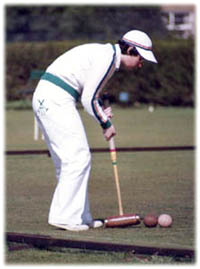
|
| Deborah Latham, the author, carefully lines up her croquet stoke, photographed by husband Laurence Latham. |
Look at any specialist magazine relating to those, or any other, sports. Then, if you receive the Croquet Gazette published by the English Croquet Association, retrieve the issues of the last few years and compare the photographic content. I can't comment on other croquet journals, as I only subscribe to the one, but I suspect a marked difference will manifest itself.
To me, that difference is that the Croquet Gazette editors of recent years appear to have had a dearth of a particular sort of photograph from contributors to include in the magazine layout, and that is photographs of croquet players playing croquet.
If you compare other sports, I venture to suggest that you will see 'action' photographs of footballers in play (quite often with two or more players in the shot), rugby players running with the ball or in mid-flight on their way to ground as they score a try or tackle an opponent, cricket batsmen having sent the ball arcing for six, swimmers at full stretch in the pool, athletes in mid-air as they hurdle, jump, or vault, and so on.
| Send us your favorite croquet photo! |
|
It could be a playing shot, a spectator shot, a reaction shot from the crowd or from the doubles pair watching from the bleachers, the gazebo or courtside. It could be a hazard shot, including troublesome weather or invasive elements running onto the court like dogs from the sidelines. Best of all, it could be a combination of all the above - the definitive, ultimate shot of croquet-in-action! There are many examples we did not include in this article, and we are certain this subject deserves AT LEAST one more article. So don't be shy, but do exercise some discretion. If your picture is judged not suitable or if we already have too many pictures of that type, it simply won't appear. Feel free to include all relevant particulars about the subject and circumstances of the picture, technical aspects, why you like the photo, or any other information that might be of interest to the reader. And be sure to include the photo-credit that should appear with the photo, which will usually be simply the name of the photographer. Low-resolution pictures suitable for the web are preferred. Your submission is assumed to include ONE-TIME web publication rights in the article sequel. Email your entry to Croquet World's editor at: BobAlman@aol.com. |
It goes without saying that such photographs have their place in any sports publication. But there are more challenging photos out there to be taken. Surely, with the growing number of players over the last decade or so, the croquet community has acquired some players who also have their share of photographic ability? (And the necessary equipment to go with it?)
Because, let's face it, the sports photographers of the world's media don't exactly crush us underfoot in their scramble to get to the best vantage points round the courts. And - in Britain, anyway - those that do tend to go for the same rather well-worn, positively clichéd setups; I wish I had a £10 note for every carefully posed shot taken from ground level with a player framed through the hoop as he or she addresses a ball swollen by perspective to the size of one of the Atlas stones in World's Strongest Man! No - unfortunately, if we want to have "normal" real action shots of croquet players, we're going to have to produce them from within the croquet community.
Since the majority of evidence supports the theory that human beings are innately contrasuggestible, reasons (which should, I fear, so often be spelled 'e-x-c-u-s-e-s') will start to emerge from the psyche at this point. "Oh, I'm just no good at taking photographs!", "the players are too far away for a good picture" - that sort of thing.
Well, I had a fair degree of success in getting photographs published in the Gazette in the late 80s to mid 90s, when I attended more tournaments than I do these days, so I would like to place before you some suggestions that seemed to work well for me, and then you can see whether you could make use of any of them. (Apologies in advance for any specialist vocabulary whose meaning I fail to explain or that can't be gleaned from the context.)
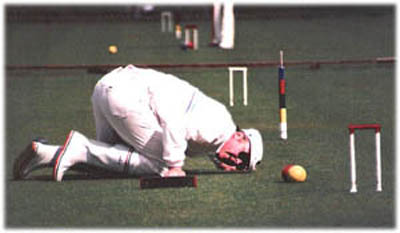
|
| Lining up a peel: Colin Irwin (Bowdon). |
Perhaps at this point I should explain that I have no formal background in photography whatever - in 1980 I graduated from a 'point-and-click' Kodak to the Minolta X-700 SLR (that's the acronym for Single Lens Reflex, by the way) that I've been using for the past 20 years or so, often in conjunction with the one 60-300mm zoom lens I possess, and have been very loyal to Boots the Chemists for developing the resulting photographs. Only last year, as a result of the Canon Powershot S60 acquired on the occasion of my 25th wedding anniversary, have I begun to venture into the possibilities offered by digital cameras. The point being that, like the majority of other croquet players, I'm not a professional photographer. I'm just someone who enjoys taking photos, capturing moments.
Try to be unobtrusive
So, with that out of the way, the very first thing I want to emphasize is - TRY TO BE UNOBTRUSIVE! Be empathetic - how would you feel if you were in tournament or club competition play and became aware of someone bobbing about on the boundary levelling a camera at you? True, some people genuinely don't mind having a lens pointed at them, but they tend to be a minority, and in any case wouldn't want to be distracted during play, so be very careful your activities are not literally putting your subject off their stroke.
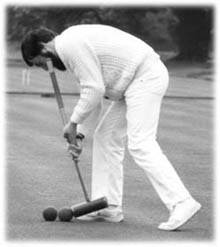
|
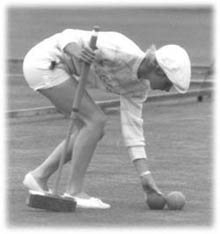
|
| Roll stroke: Laurence Latham (not a member of any club at this time). | Positioning the balls by hand for a croquet stroke: Debbie Cornelius (Colchester). |
This includes the timing of shutter operation. Empathy again - would you like to hear a loud, distracting 'click' just as you were addressing the ball, resulting in a fatal loss of concentration and a wild mis-hit? No? Then either press the shutter button while the stroke is still being lined up, or the instant after the ball has been struck, but not as it is about to be, 'on the downswing'. (I should mention here that I particularly have in mind the use of SLR cameras, whose shutter actions are fairly audible, as opposed to the quieter digital cameras.)
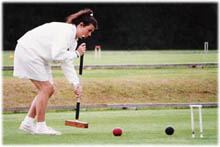
|
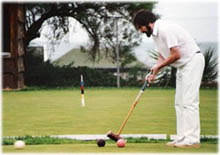
|
| Hoop approach: Beatrice McGlen (Nottingham) – notice that the photo was taken after the shot has been struck. | Rush shot: Laurence Latham playing a rush along the east boundary of Lawn 3 at Sidmouth Croquet Club in Devon. Again, note that the photo has been taken after the shot has been played. |
If you're using a digital camera like mine, the problem with timing the shutter
release is that depressing the button is a two-step process - halfway down to
activate the automatic focus, then all the way to take the photo. This means it
may involve some application (that's spelled 'practice' - or maybe 'practise',
depending which continent you're on) on your part to become sufficiently
familiar with the operation of the digital camera to accurately assess when to
start that downward pressure of the index fingertip, but it'll be worth it!
Zooming into focus with digital technology
The real secret of my success (such as it was) with croquet photographs was having an SLR camera with a zoom lens. However, if your digital camera is set to a sufficiently high resolution (ie the number of pixels or 'dots' per inch that create the image), it should be possible to take a photograph from visually 'further away' than the picture a zoom lens will produce, and the area of the photograph specifically containing the player cropped, thus discarding the surrounding background. If necessary such a cropped image can be enlarged to a satisfactory size without too much loss of picture quality (eg using a 'professional' graphics program such as Photoshop or even Paint, CorelDraw, Publisher, IrfanView, etc). Even if you can't do this yourself, don't let it stop you taking the photograph in the first place - there'll be someone somewhere who can!
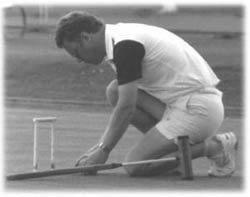
|
| Positioning the balls for a backward takeoff hoop approach: John Toye (Budleigh Salterton). |
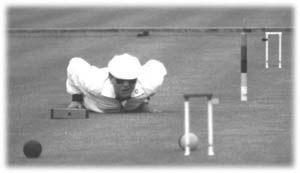
|
| Lining up a peel: David Cairns (Cheltenham). |
The most photogenic playing stances
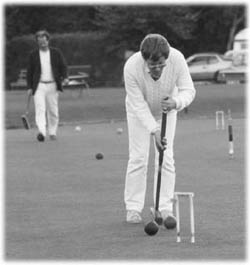
|
| Double-banked players: Geoffrey Taylor (Cheltenham) approaching a hoop with Paul Smith (Cheltenham) in the background. |
A key element here is being able to see enough of the player's face to be able to recognize who they are (assuming you know them in the first place, of course!). Clearly a photograph from behind does not achieve this particular criterion, but surprisingly often, neither does a shot from head on. This is because, when in play, the player is often looking down, as indeed they should be as they strike the ball, and therefore what you mostly see is the top of their head, not their face.
So, unless they have a particularly recognizable top to their head (!) the best opportunities are offered by a stance where they are at least at a 45 degree angle to you, and ideally are sideways on.
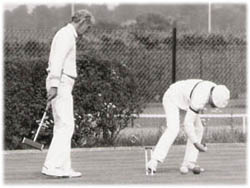
|
| Refereed shot: David Cairns (Cheltenham) refereeing Bernard Neal (All England Lawn Tennis and Croquet Club, Wimbledon). |
Then again, some shots are more photogenic than others. Refereed shots, positioning the balls for the croquet stroke (whether using hand or foot), a roll stroke, running a hoop, lining up a peg-out or a peel, are all good 'action' shots. Capturing a player in a fairly inactive stance but with the opponent or spectators at the court side also visible in shot can be an interesting combination, too. The body language of out players can be quite fascinating, let me tell you!
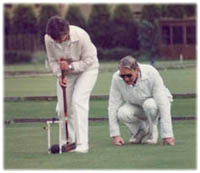
|
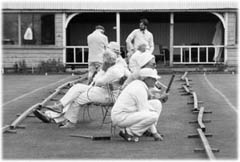
|
| Refereed shot: Bernard Neal (All England Lawn Tennis and Croquet Club, Wimbledon) refereeing a shot for Carol Smith (Cheltenham). | Out players on Doubles morning at Cheltenham. |
The examples shown here (all, with one exception, taken at Cheltenham Croquet Club, Gloucestershire, in the 1980s and 1990s - some of them dating back to when the technology of the day meant that black-and-white photos were the preferred format for submission to the Gazette) are not included because of the standard of the photographs themselves, but as illustrations to give you a flavour of what I mean by a croquet 'action' shot.
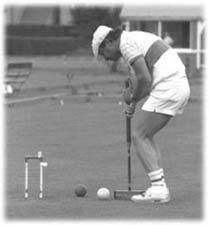
|
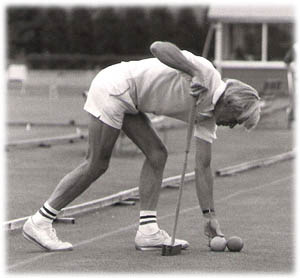
|
| Making a roquet: David Cairns (Cheltenham). | Positioning the balls by hand for a croquet stroke: Dennis Moorcraft (Cheltenham). |
I steadfastly maintain that if I can do it, so can you! So it's my hope that with the benefit of some of the foregoing suggestions, which I'm sure many of you can improve upon, perhaps more of us can shoot ourselves! Not in the foot, I sincerely trust, but for the benefit of Posterity (History, even?), ourselves, and our croquet colleagues (not forgetting our hard-working Editor of the day), by enlivening the pages of our 'journals of record' with images of croquet players who are actually playing croquet!
Deborah Latham lives in Taunton, Somerset, England. She began her croquet career shortly after her marriage in 1980 to Laurence, whose own club career began at Bristol in 1968. (They are both Croquet Association members but have not belonged to a specific club since the late 80s.) Deborah played in her first Croquet Association tournament in 1981, being at the time the only junior (under 24 years old) female member of the CA. In tournament play her most notable achievement was winning the Ladies' Peels Bowl in 1986, the same year in which Laurence won the Men's event, a husband-and-wife double achieved by only one other married couple since the competition's inception in 1898. Deborah has been a regular contributor of articles and photographs to the Croquet Gazette over the years and currently illustrates the 'Hoopopotamus' strip cartoon innovated by her husband in 2002. She also designed the weather vane that now stands on the roof of the clubhouse at Cheltenham as a tribute to G E P (Edgar) Jackson, a distinguished player and member of the club from the 1950s to the 1980s.